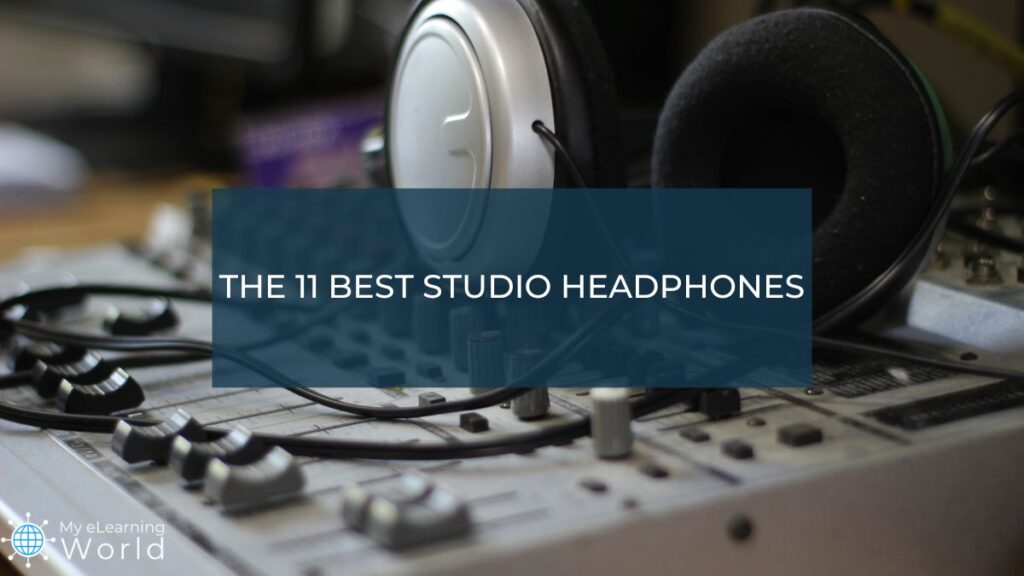As an instructional designer who’s spent countless hours in my home studio recording voiceovers for eLearning modules, one of the most important things I’ve learned is the tools we use to create our content can make or break the learning experience. And while you might think the microphone is the only thing that matters when recording voiceovers, I’m here to tell you that the headphones you use also play a pivotal role in ensuring the clarity and quality of your recordings.
The right studio headphones provide an accurate representation of sound, allowing you to catch subtle nuances, background noises, or inconsistencies that might otherwise go unnoticed in your recording project.
That’s why I’ve reviewed and ranked the best studio headphones, offering quality picks across different categories and for every price point (click here to learn about our entire Editorial Process & Methodology for product reviews). From budget studio headphones and high-end models to headphones specifically designed for voice over work, I’ve tried dozens of different products, and curated a list of 11 of the very best products available today.
This guide has been fully updated for 2023, so you can make sure you’re getting current, accurate info to help you find the right pair of headphones for your needs.
My Quick Suggestions
To save you some time, here are some suggestions from my research and testing. These voice-over headphones all deliver great results and come with features to deliver quality recordings for all skill levels:
- Sennheiser HD280PRO – Affordable on nearly any budget, these studio headphones are comfortable with adjustable cups and closed-back design for attenuation of ambient noise, trusted brand with over 75 years in the recording industry
- Beyerdynamic DT 770 PRO – Mid-range price for professional studio quality monitoring, versatile for use in voice-over work and instrument recording, comfortable and replaceable ear pads, able to use with mobile recording devices as well as in-studio applications and hardware
- Audio-Technica ATH-R70x – Neutral tuning for accurate voice-over monitoring, acoustically transparent to allow for hearing of your own voice during performances, can be used with a range of headphone amplifiers
Now let’s move on to the full list of headphones that are ideal for voice-over in your home studio. I’ll analyze in detail their characteristics, explain the reason why I chose them, and help find the best option for you.
 |
The industry standard, lightweight, comfy, great for voice-over pros and beginners. Type: closed-back
My choice among the closed-back studio headphones!
|
Check price |
 |
High end, great dynamic range, mids, bass, and highs. Soft on the ears! Type: open back headphones
|
Check price |
 |
A pro choice, appealing design, solid noise reduction, high frequency response. Type: closed-back
|
Check price |
 |
Superb low tones, smart price, natural sound, bass, ergonomic and foldable. Type: closed-back
|
Check price |
 |
Cost-effective, soft ear cushions, great highs, and mid-range, 2yr warranty. Type: closed-back
|
Check price |
 |
Nice mid-range option, wide frequency range, 250-ohm drivers, lightweight diaphragm. Type: open back headphones
|
Check price |
 |
Perfect headphones for voice-overs, nice look and sound, noise-free, adjustable headband. Type: closed-back
|
Check price |
 |
Pure audial pleasure, circumaural design, well-balanced, ergonomic, and durable. Type: open back headphones
|
Check price |
 |
Over-ear design, firm bass, rich dynamic range, adjustable; a smart choice! Type: semi-open back headphones
|
Check price |
 |
Spacious sound, lightweight, big breathable cups, natural and clear sound. Type: open back headphones
My choice among the open-backs!
|
Check price |
 |
Good studio headphones for voice overs, no sound leaks, soft cups, foldable, nice cabling. Type: closed-back
|
Check price |
What are the Best Studio Headphones?
1. Sennheiser HD280PRO →
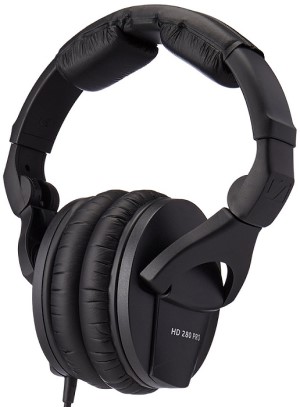
is the industry standard, which might be true, as far as I’m concerned.
That’s why this is my pick for the best studio headphones for voice over work that you can buy.
Other headphones just don’t quite measure up to this one with its excellent sound reproduction, accurate frequency response, comfortable design, and proven performance.
Looking for dynamic closed-back headphones? HD280 could be your top choice.
What’s inside?
- Foldable ear cups for easy, safe transport.
- Utilizes durable single-sided cable for convenient management.
- Linear sound reproduction with high ambient noise attenuation.
Why I picked it:
- Lightweight, ergonomic, nice look and feel.
- Warm, natural sound with no extra gadgets involved.
- One of the most best values on the market in terms of price and quality.
- Ambient noise attenuation really helps with natural sounds like the human voice, but sound reproduction remains uncolored and neutral.
- Sennheiser is one of the most respected names in pro audio with a proven track record of creating superior gear.
Best for:
- Budget-conscious studio owners.
- Vocal recording artists who work in more than one location.
- Voice-over talent who require high-quality monitoring when performing on location.
These headphones are the epitome of comfortable. Nifty around-the-ear design, ear cups that really stand out – well… metaphorically speaking.
Here’s a brief video review of HD280PRO. The review includes main tech features, applications and purchase tips:
2. Sennheiser HD 650 →
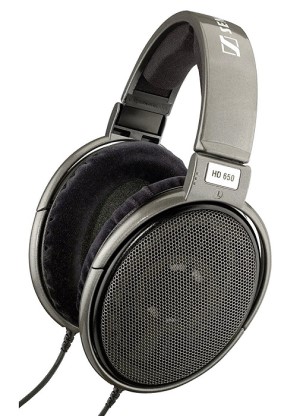
appeals to pros and covers amateur needs as well.
What’s inside?
- High power neodymium magnets for top efficiency.
- Lightweight voice coils for rapid transient response.
- Hand-picked pair of response units with narrow tolerances of ± 1dB.
- Detachable cable made specially to eliminate signal noise using highly conductive OFC copper.
Why I picked it:
- Real high-end and everything that goes with it.
- Incredible dynamic range.
- Miraculous mids and bass, and clear highs.
- Great extension and sound stage, boosted frequency response at 10 – 39,500 Hz (-10 dB).
- Custom-designed acoustic silk helps to reduce total harmonic distortion to as little as 0.05%.
Best for:
- Audiophiles who demand high-quality playback.
- Voice-over artists who perform a range on roles.
- Studio professionals looking for headphones targeted toward transient detail.
Need a soft touch on the ears? You got it!
Take a look at the video and judge for yourself why these are considered some of the best studio headphones on the market:
3. Sony MDR7506 →
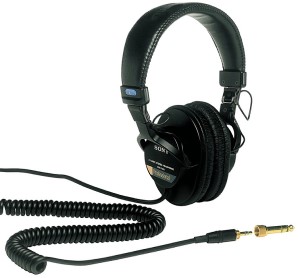
offers balanced low, medium and high tones and are a great choice for studio headphones for recording at home.
What’s inside?
- Comes with protective carry pouch and gold-plated adaptor.
- Can connect to portable recording and listening devices for work on the road.
- Easily handles frequencies up to 20kHz.
- Mid-range price is the sweet spot for home studio voice-over artists.
Why I picked it:
- The overall design makes a good impression, the headband will work fine for any taste, and the ear cups are soft and comfortable.
- Sound leakage is minimal, with solid noise reduction. Great overall sound quality. Frequency response of 10Hz – 20 kHz.
- Versatile connection options for use in both studio voice-over work and personal listening enjoyment.
Best for:
- Voice-over artists who need a fast and easy monitoring solution that connects to different types of hardware.
- Home recording studio engineers.
- Vocal recording artists on a budget who want to save money.
These recording headphones fold up easily in case you need to travel or store them with a minimal ‘footprint’.
4. Sony MDRXB800 →
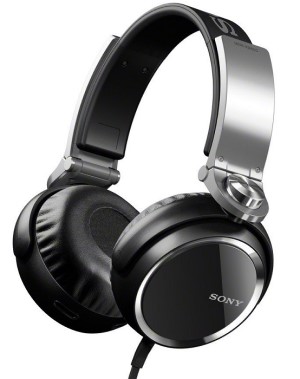
has an edge over the competition in the low tones, and many more perks!
What’s inside?
- Padded ear cups aid in comfort for long listening sessions.
- Hinged headband makes for easy storage and transport.
- Frequency response dips down to 3Hz according to Sony.
Why I picked it:
- Cheap, stylish, foldable, smart construction (earpiece-earpiece design-over-the-head) – what else could you ask for?
- Cable length – 3.94 ft; maximum frequency response at 28 kHz.
- Realistic, natural sound quality, and bass, genuine BASS, if you are into it.
Best for:
- Vocal recording pros who want to connect to multiple devices.
- Recording engineers who want to reference mixes using consumer headphones.
- Baritone voice-over artists seeking extra-strength bass.
How else is it different from the MDR7506? Get more insights from a popular vlogger:
5. Beyerdynamic DT 770 PRO →
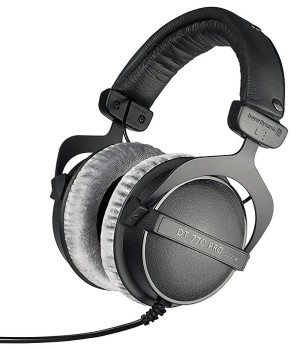
tops the list of the best headphones for recording vocals and voice overs, providing quality sound and improved bass response.
What’s inside?
- Circumaural technology provides natural sound in the studio and through mobile devices.
- Full frequency response with a neutral tuning to reproduce crisp highs and deep lows.
- Spring steel headband for flexibility and padded ear cups provide comfort during long sessions.
- Single-sided cable reduces clutter and tangled messes.
Why I picked it:
- A nice trade-off between solid features and a reasonable price.
- Stylish design with rugged headband construction.
- Comfort and ease-of-use with single-sided cableSoft ear cushions.
- Impressive high and mid-range reproduction.
- 2-year warranty if purchased from an authorized reseller.
Best for:
- Voice-over artists who record while traveling.
- Recording engineers needing monitoring headphones for both music and vocal work.
- Voice-over artists who work from home.
Learn more details in this HomeTracks review and consider these headphones for your home recording studio:
6. Beyerdynamic DT-990-Pro-250
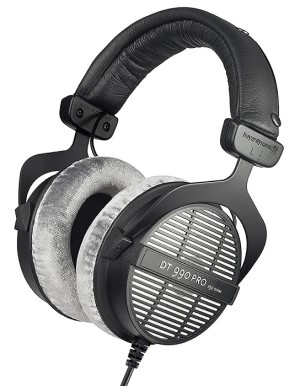
open-back from Beyerdynamic offers an extraordinarily wide frequency range, and more!
What’s inside?
- 250-ohm drivers, superb sound reproduction.
- Lightweight diaphragm and exceptional impulse performance.
- Pro model features a coiled cable for easier management and less mess.
- Both the ear cups and the headband are snug but comfortable without causing tension.
- Open-back design reduces pressure and artificial bass to ensure neutrality.
Why I picked it:
- Like the DT 770, this one has an adjustable, padded headband construction, and goes soft on your ears thanks to the tender velour ear pads.
- All this comes with a traditional 2-year manufacturer warranty.
- Excellent sound reproduction for voice-over work and music mixing.
- Wide stereo image allows for pinpoint accuracy in panning and mixing voice-over takes with other audio.
- Affordable price but with high-end results.
Best for:
- Professional and home studio recording engineers.
- Voice-over artists who are ready to step up from enthusiast headphones.
- Podcasters looking for an affordable, professional monitoring solution.
Get more information from this HardwareCanucks review and see which Beyerdynamic product meets your requirements:
7. Shure SRH1540 →
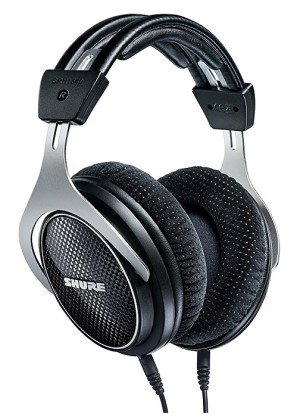
looks gorgeous and never fails in terms of quality, be it voice-overs or any other possible scenario.
What’s inside?
- Steel driver frame for improved linearity, eliminated internal resonance and smooth performance at various levels.
- Carbon fiber construction provides durability and long-lasting performance.
- 40mm neodymium drivers create a rich sound stage with warm bass and crisp high-end.
- Features a closed-back design for improved isolation and full sound.
- Comes with a storage case, replacement ear pads, a threaded adapter, and replacement cable.
Why I picked it:
- It’s a perfect blend of good looks and good sound, with utmost comfort included.
- The headphones have garnered a bunch of positive reviews from voice-over pros, high-end fans and audiophiles across the globe. All these people just can’t be wrong, and I totally agree.
- An extensive soundstage with clear highs and warm basses.
- The classic closed-back design helps reduces background noises.
- Ergonomic, fully adjustable headband for ultimate comfort.
Best for:
- Home and professional studio engineers.
- Voice-over artists who want to monitor full-range performances.
- Vocal artists who want headphones that will last for years.
Feel free to learn more in an elaborate video clip from Z Review:
8. Shure SRH1840 →
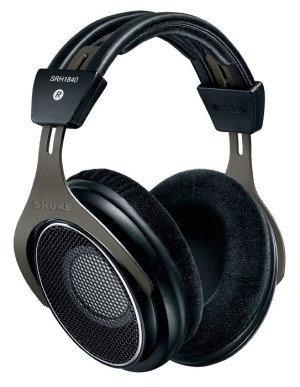
open-back raises the bar for a full, truly absorbing audial experience.
What’s inside?
- Open-back design allows for neutral monitoring without bass pressure or harsh transients.
- Includes replacement velour ear pads, carrying case, replacement cable and threaded adaptor.
- Full sound with no over-tuned response, perfect for use in monitoring, mixing and mastering.
Why I picked it:
- The circumaural design makes for natural sound, wide stereo and boosted field depth.
- External noises aside, the sound is well balanced with solid bass, mids in the right spectrum, and highs bright and clear.
- Lightweight, yet durable – a close rival to its SRH1540 sibling!
Best for:
- Studio engineers who require neutrality in sound reproduction.
- Voice-over artists seeking a monitoring solution that brings out natural details in voice work.
- Recording professionals who are ready to move up from mid-tier pricing.
Great review by Damir Franc will give you more details about these headphones!
9. AKG K 240 MK II →
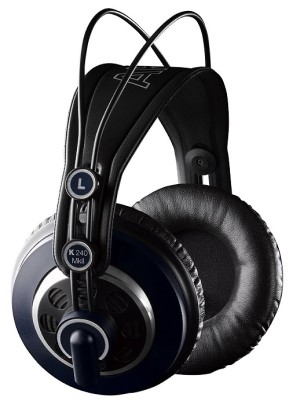
model follows this remarkable legacy and adds more features.
What’s inside?
- Utilizes 30mm XXL transducers to reproduce natural sound without over-tuning highs or lows.
- Back design is semi-open, allowing a combination of natural clarity mixed with isolation for improved detail.
- The provided mini-XLR cable is perfect for connecting to professional recording gear in the studio, at home or in the field.
Why I picked it:
- The over-ear design gives you an awesome feeling, however long the voice-over.
- Check it out and appreciate the firm bass, airy highs, and ample dynamic range.
- The headband can be self-adjusted to cater to individual preferences.
Best for:
- AKG is undoubtedly one of the most celebrated standards for studios, orchestras and stages.
- Top pick for audiophiles and sound professionals worldwide.
- Vocal pros who want to hear everything around them as they work
For a quick unboxing and thoughts on this model, watch this video review:
10. Audio-Technica ATH-R70x →
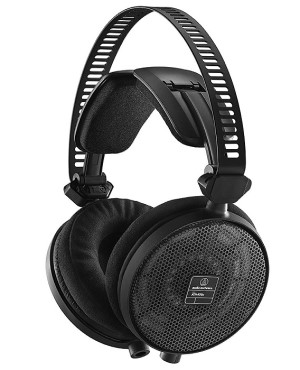
will make most picky audiophiles happy.
What’s inside?
- The model comes with nifty magnets and a pure alloy magnetic circuit that help to eliminate distortion and increase high-frequency response.
- Acoustically transparent housings reduce unwanted coloration and reproduce natural performances
- Features a dual-sided detachable cable for customizing the listening experience
- Utilizes carbon composite resin to remove transient bite
- Lightweight, yet durable, for added comfort and protection
Why I picked it:
- Incredibly light to wear, with big comfortable cups – ATH R70x will deliver the utmost usability even for long recording sessions.
- The ear pads are soft and breathable.
- As for the sound, it reaches the highest standards – natural and clear.
- The open-back design delivers a flat response for neutral monitoring during recording and while mixing and mastering vocal takes and more.
- All this with an approximate weight of 0.5 lbs/220 g.
Best for:
- Professional studio engineers
- Voice-over artists who are ready to move up to pro-audio quality and price
- Recording engineers who need to monitor subtle and nuanced vocal takes
Need video proof? You got it! Learn how these headphones perform in real life, and why the reviewer thinks they stand out from the competition:
11. Status Audio CB-1 →
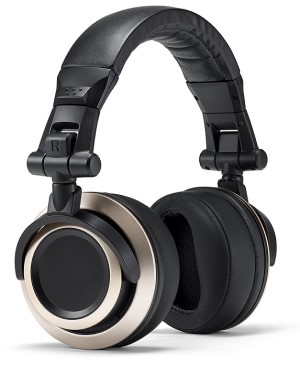
has been designed for pro use and covers all voice-over needs from A to Z. You got all you need in these closed-back studio headphones – no sound leaks, no distractions, and no hiccups.
What’s inside?
- Utilizes 50mm drivers with a closed-back design, but delivers a neutral monitoring experience for mixing vocal takes
- Detachable cable for clean organization in the studio
- 3.5mm plug can be adapted to 1/4” for use with many hardware devices
Why I picked it:
- Aside from nice sound rejection, Status excels in durability.
- However far you try stretching the band, don’t expect any cracks or breaks. It’s rock-solid, yet flexible.
- The ear-pads are soft, smooth, and ergonomic, attaining the same or higher level of comfort as the close competitors on the list.
- Moreover, these headphones are foldable. Looking for a smaller form factor? All you need is a gentle touch, and they fold.
- The package comes with decent cabling: two detachable cables, coiled and straight, with twist-lock available.
Best for:
- Voice-over artists seeking an entry-level monitoring solution
- Music enthusiasts who need a pair of inexpensive closed-back headphones
- Home studio users who are learning about recording and engineering sessions
A CLE Tech review suggests this might be the best pair of headphones under $100. Watch the video, and judge for yourself:
Choosing the Best Studio Headphones for Your Needs
Finding the right recording headphones for voice-over work or home studio use can seem daunting. What options should I look for? What features do I need? Does brand or price matter?
Thankfully, finding the right studio headphones can be easy by following these five simple tips:
1. Understand Your Needs
Headphones can be used for monitoring vocal performances during recording, but most headphones aren’t always the best choice when it comes to mixing and mastering recordings.
As a result, look for mixing and mastering headphones that provide a flat response so you get an accurate representation of your vocal work during the recording process. Headphones that are heavily tuned toward bass tones can cause an unnatural and muddy sound that distorts your EQing and mastering.
With this stated, high-end headphones can be used for mixing and mastering as long as they are designed with neutrality in mind.
2. Think of Your Comfort

This means you may be wearing studio headphones for varying lengths of time, including for hours a day if you’re recording voice-over work for lengthy videos.
If you’re wearing uncomfortable recording headphones the whole time, you may not be ready to give your best performance, so look for studio headphones that include comfort features like adjustable clamp tightness, cup extenders and cushioned over-the-ear cups.
3. Price Doesn’t Determine the Right Fit
In life, you often get what you pay for. This may lead you to believe that the most expensive pair of voice-over headphones will deliver the best performance, but that may be incorrect.
Once again, it all comes down to your recording needs and how you plan to use the studio headphones.
An expensive pair of studio headphones that has been designed specifically for simulated surround sound may cost more than a pair of recording headphones designed for vocal monitoring, but the vocal monitoring headphones will likely better meet your needs.
4. Consider Connectivity

While this method is still preferred among most professional studios, wireless technology has made major advancements in recent decades toward providing a similar listening experience with very low latency in the field of vocal recording.
As a result, consider what type of connection you will need between your studio headphones and your recording equipment prior to making a decision.
Also, think about the future and where you see the industry moving in terms of wired vs. wireless options down the road. Keep in mind that technology changes fast, so it may be better to stick with trusted connection methods until you have a chance to see how things will play out instead of investing in a gimmick that won’t last more than a few years at the most.
5. Think About Extra Equipment
If you’re new to purchasing headphones for recording and voice-over work, you may think studio headphones work just like retail headphones that connect to a source for listening to music. While this is technically the case, many studio headphones, especially those on the higher end of the price and quality scale, will require amplification in order to get the most out of them.
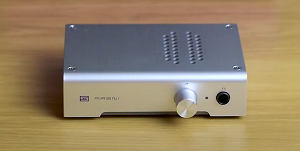
A headphone amplifier may be an additional piece of hardware that will be utilized to control the volume of source material being fed to the headphones, but it may also provide power to an amplification unit built into the headphones.
An amplifier is also used to reduce signal noise for the cleanest, clearest sound possible. Before purchasing a pair of voice-over headphones, check to see if you will need to also purchase an amplifier or other hardware so that you’ll be ready to record, monitor and mix your tracks from day one.
FAQ
What are the main types of studio headphones?
There are a few different types of studio headphones for recording:
- Closed-back, over ear headphones
- Open-back, over ear headphones
- In-ear headphones
While closed-back studio headphones tend to be the best choice for recording, the others still offer various benefits, such as comfort.
What’s the difference between studio headphones and normal headphones?
Thinking about trying to use your regular headphones for recording?
Regular headphones don’t have the same range as studio headphones and won’t deliver the kind of sound quality you need for recording. They’re not designed for mixing, and they often have various boosts.
Studio headphones are designed to let you fully hear everything that’s going on in your mix, so you can pick up on fine details that may need to be refined or edited out. The result is your final product has better sound quality for listeners to enjoy.
Furthermore, the best studio headphones are simply more durable and sturdy than regular headphones, so they’ll last longer and deliver better sound quality for your recording and mixing purposes.
How much do studio headphones cost?
Recording headphones come in a wide range of prices, and more expensive doesn’t always mean better. You could spend anywhere from around $100 to $300 or more on a pair of studio headphones, depending on your needs.
A Final Word on the Best Studio Headphones
Am I missing some studio headphones brand that deserves attention? Give me a shout! Any feedback is welcome. You can also check out my guide to the best headset microphones.
Looking to get more education in the field of voice over work? Make sure to check out our voice over classes guide!
Have any questions about choosing the best studio headphones for recording at home? Leave a comment below.

